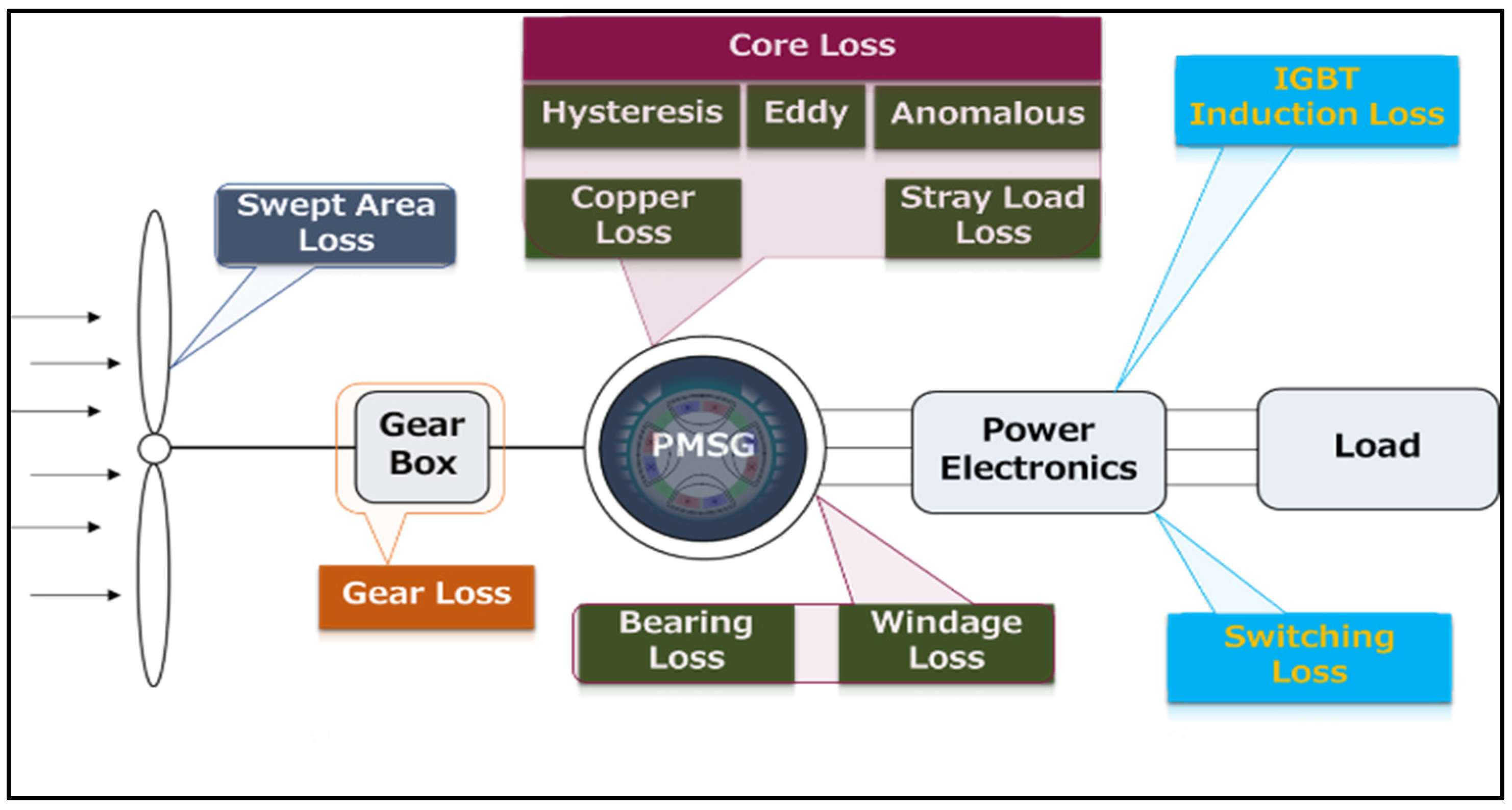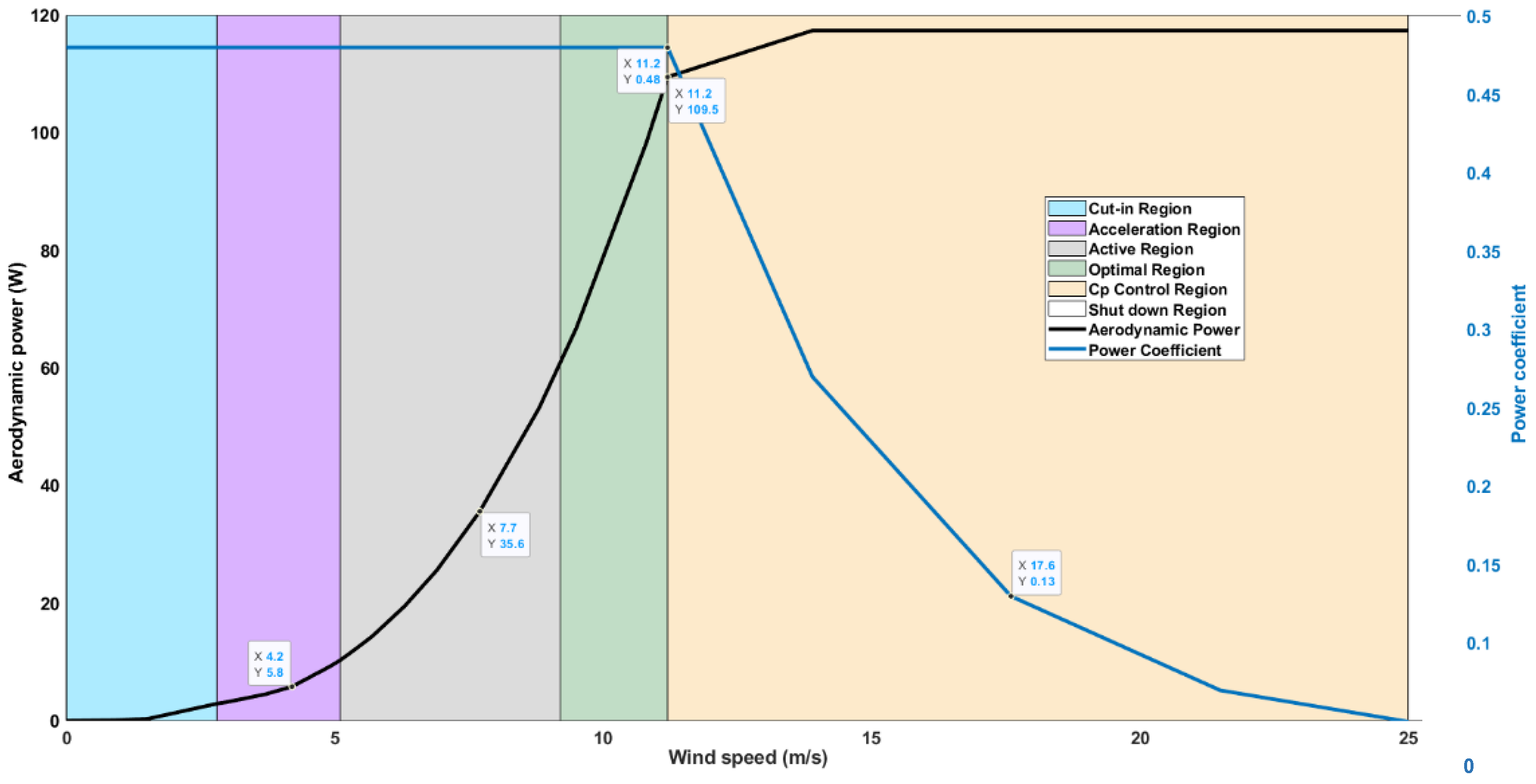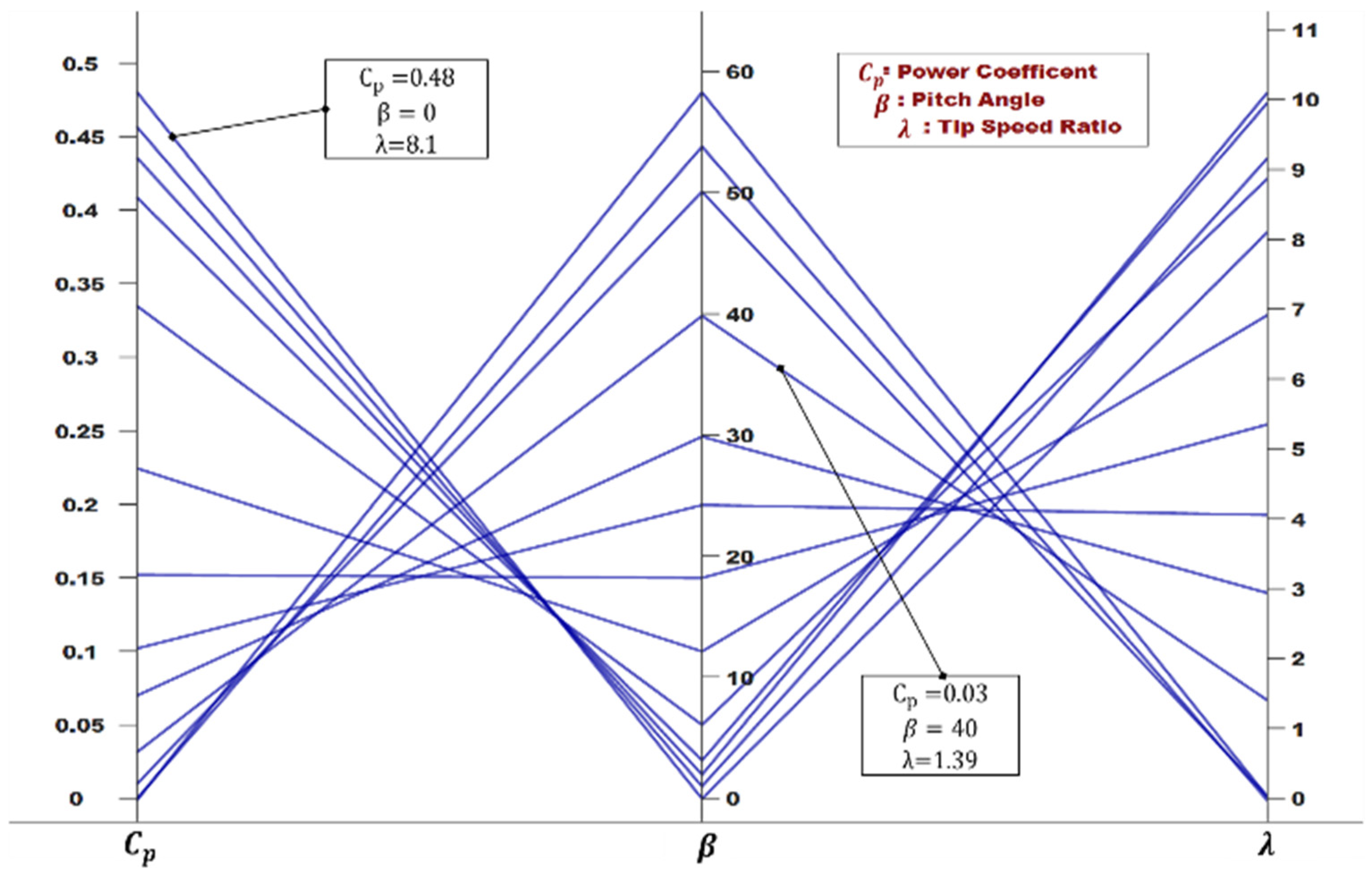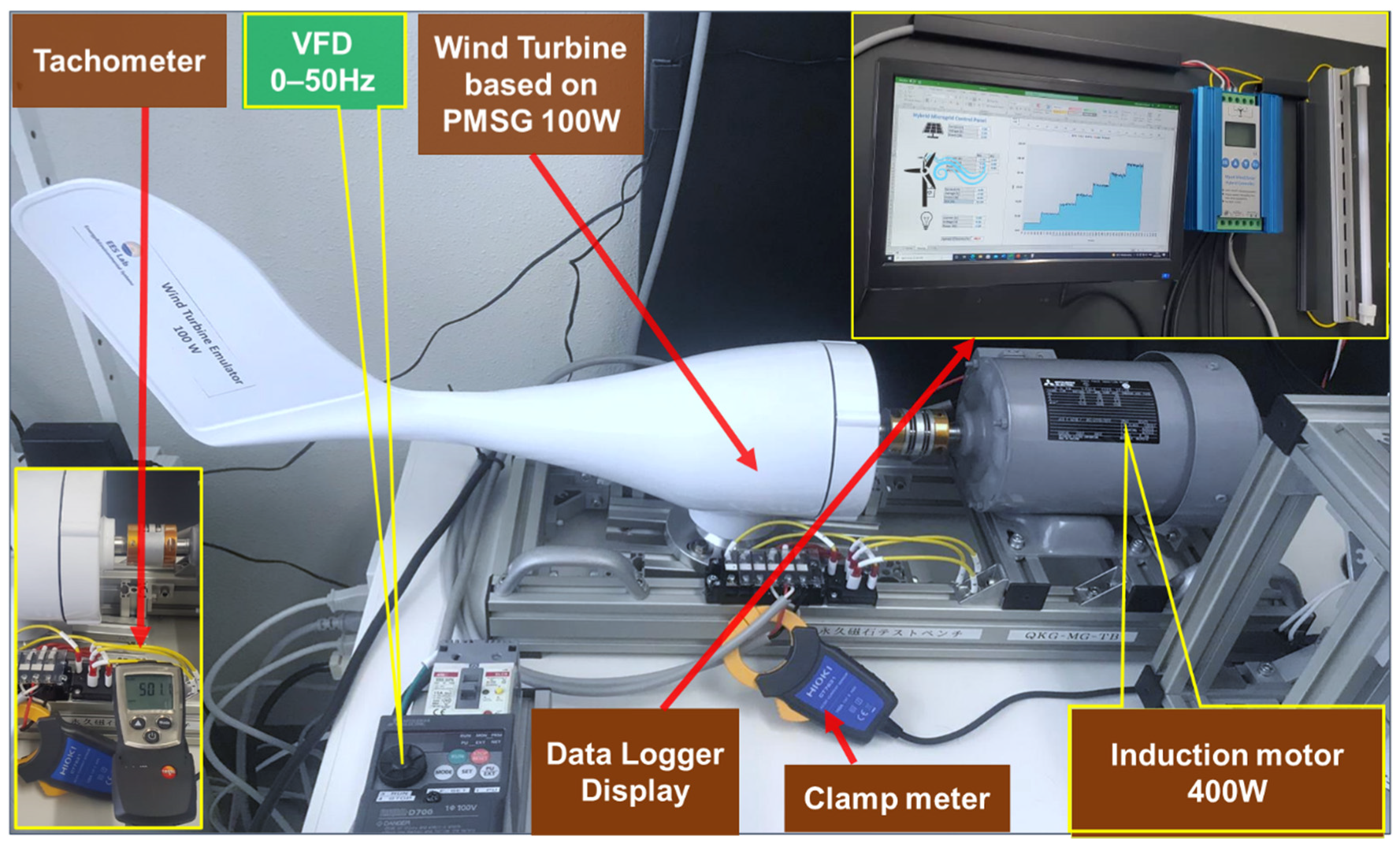Model for Optimal Power Coefficient Tracking and Loss Reduction of the Wind Turbine Systems
Abstract
1. Introduction
1.1. Background and Literature Review
1.2. Research Gap and Originality Highlights
2. Model Development
3. Results and Discussion
3.1. Estimation of the Optimal Value of the Power Coefficient in a Direct Drive Configuration
3.1.1. Power Loss Estimation Based on the Optimal Value of Cp
3.1.2. Validation of the Model Results with the Experimental System
3.2. Model Application to a Real Case Study in Pakistan Considering the Indirect Drive Configuration
4. Conclusions
Author Contributions
Funding
Institutional Review Board Statement
Informed Consent Statement
Data Availability Statement
Conflicts of Interest
References
- Yoshida, Y.; Farzaneh, H. Optimal design of a stand-alone residential hybrid microgrid system for enhancing renewable energy deployment in Japan. Energies 2020, 13, 1737. [Google Scholar] [CrossRef]
- Esteban, M.; Portugal-Pereira, J.; Mclellan, B.C.; Bricker, J.; Farzaneh, H.; Djalilova, N.; Ishihara, K.N.; Takagi, H.; Roeber, V. 100% renewable energy system in Japan: Smoothening and ancillary services. Appl. Energy 2018, 224, 698–707. [Google Scholar] [CrossRef]
- Hinokuma, T.; Farzaneh, H.; Shaqour, A. Techno-economic analysis of a fuzzy logic control based hybrid renewable energy system to power a university campus in Japan. Energies 2021, 14, 1960. [Google Scholar] [CrossRef]
- Ugranli, F.; Karatepe, E. Optimal wind turbine sizing to minimize energy loss. Int. J. Electr. Power Energy Syst. 2013, 53, 656–663. [Google Scholar] [CrossRef]
- Hung, D.Q.; Mithulananthan, N.; Bansal, R.C. Analytical strategies for renewable distributed generation integration considering energy loss minimization. Appl. Energy 2013, 105, 75–85. [Google Scholar] [CrossRef]
- Ochoa, L.F.; Harrison, G.P. Minimizing energy losses: Optimal accommodation and smart operation of renewable distributed generation. IEEE Trans. Power Syst. 2011, 26, 198–205. [Google Scholar] [CrossRef]
- Chen, W.H.; Wang, J.S.; Chang, M.H.; Mutuku, J.K.; Hoang, A.T. Efficiency improvement of a vertical-axis wind turbine using a deflector optimized by Taguchi approach with modified additive method. Energy Convers. Manag. 2021, 245, 114609. [Google Scholar] [CrossRef]
- Baran, J.; Jaderko, A. A method of maximum power point tracking for a variable speed wind turbine system. In Proceedings of the 2019 Applications of Electromagnetics in Modern Engineering and Medicine (PTZE), Janow Podlaski, Poland, 9–12 June 2019; Volume 2, pp. 13–16. [Google Scholar] [CrossRef]
- Vijayalakshmi, S.; Ganapathy, V.; Vijayakumar, K.; Dash, S.S. Maximum Power Point Tracking for Wind Power Generation System at Variable Wind Speed using a Hybrid Technique. Int. J. Control Autom. 2015, 8, 357–372. [Google Scholar] [CrossRef][Green Version]
- Yaakoubi, A.E.; Amhaimar, L.; Attari, K.; Harrak, M.H.; Halaoui, M.E.; Asselman, A. Non-linear and intelligent maximum power point tracking strategies for small size wind turbines: Performance analysis and comparison. Energy Rep. 2019, 5, 545–554. [Google Scholar] [CrossRef]
- Pande, J.; Nasikkar, P.; Kotecha, K.; Varadarajan, V. A review of maximum power point tracking algorithms for wind energy conversion systems. J. Mar. Sci. Eng. 2021, 9, 1187. [Google Scholar] [CrossRef]
- Xia, Y.; Yin, M.; Li, R.; Liu, D.; Zou, Y. Integrated structure and maximum power point tracking control design for wind turbines based on degree of controllability. JVC J. Vib. Control 2019, 25, 397–407. [Google Scholar] [CrossRef]
- Lanzafame, R.; Messina, M. Horizontal axis wind turbine working at maximum power coefficient continuously. Renew. Energy 2010, 35, 301–306. [Google Scholar] [CrossRef]
- Wei, L.; Zhan, P.; Liu, Z.; Tao, Y.; Yue, D. Modeling and analysis of maximum power tracking of a 600 kW hydraulic energy storage wind turbine test rig. Processes 2019, 7, 706. [Google Scholar] [CrossRef]
- Adams, T.M.; Mertz, B.E. Horizontal Axis Wind Turbine Power Coefficient as Relative Capture Area. J. Fluid Flow Heat Mass Transf. 2021, 8, 254–261. [Google Scholar] [CrossRef]
- Sohoni, V.; Gupta, S.C.; Nema, R.K. A Critical Review on Wind Turbine Power Curve Modelling Techniques and Their Applications in Wind Based Energy Systems. J. Energy 2016, 2016, 8519785. [Google Scholar] [CrossRef]
- Chinamalli, P.K.S.; Naveen, T.S.; Shankar, C.B. Power Loss Minimization of Permanent Magnet Synchronous Generator Using Particle Swarm Optimization. Int. J. Mod. Eng. Res. 2021, 2, 4069–4076. Available online: http://www.ijmer.com/papers/Vol2_Issue6/AO2640694076.pdf (accessed on 1 December 2021).
- Lap-Arparat, P.; Leephakpreeda, T. Real-time maximized power generation of vertical axis wind turbines based on characteristic curves of power coefficients via fuzzy pulse width modulation load regulation. Energy 2019, 182, 975–987. [Google Scholar] [CrossRef]
- Song, D.; Liu, J.; Yang, Y.; Yang, J.; Su, M.; Wang, Y.; Gui, N.; Yang, X.; Huang, L.; Joo, Y.H. Maximum wind energy extraction of large-scale wind turbines using nonlinear model predictive control via Yin-Yang grey wolf optimization algorithm. Energy 2021, 221, 119866. [Google Scholar] [CrossRef]
- Jia, L.; Hao, J.; Hall, J.; Nejadkhaki, H.K.; Wang, G.; Yan, Y.; Sun, M. A reinforcement learning based blade twist angle distribution searching method for optimizing wind turbine energy power. Energy 2021, 215, 119148. [Google Scholar] [CrossRef]
- Santiago, J.A.E.; Danguillecourt, O.L.; Duharte, G.I.; Díaz, J.E.C.; Añorve, A.V.; Hernandez Escobedo, Q.; Enríquez, J.P.; Verea, L.; Galvez, G.H.; Portela, R.D.; et al. Dimensioning optimization of the permanent magnet synchronous generator for direct drive wind turbines. Energies 2021, 14, 7106. [Google Scholar] [CrossRef]
- Inoue, A.; Ali, M.H.; Takahashi, R.; Murata, T.; Tamura, J.; Kimura, M.; Futami, M.; Ichinose, M.; Ide, K. A calculation method of the total efficiency of wind generator. In Proceedings of the 2005 International Conference on Power Electronics and Drives Systems, Kuala Lumpur, Malaysia, 28 November–1 December 2005; Volume 2, pp. 1595–1600. [Google Scholar] [CrossRef][Green Version]
- Cui, J.; Liu, S.; Liu, J.; Liu, X. A comparative study of MPC and economic MPC of wind energy conversion systems. Energies 2018, 11, 3127. [Google Scholar] [CrossRef]
- Telecommunications, C.; Crawford, T.; Hill, G. A Low-Speed, High-Torque, Direct-Drive Permanent Magnet Generator for Wind Thrbines. In Proceedings of the Conference Record of the 2000 IEEE Industry Applications Conference. Thirty-Fifth IAS Annual Meeting and World Conference on Industrial Applications of Electrical Energy, Rome, Italy, 8–12 October 2000; pp. 147–154. [Google Scholar]
- Huynh, C.; Zheng, L.; Acharya, D. Losses in high speed permanent magnet machines used in microturbine applications. J. Eng. Gas Turbines Power 2009, 131, 2–7. [Google Scholar] [CrossRef]
- Choi, J.Y.; Ko, K.J.; Jang, S.M. Experimental works and power loss calculations of surface-mounted permanent magnet machines. J. Magn. 2011, 16, 64–70. [Google Scholar] [CrossRef][Green Version]
- Muyeen, S.M. Wind Energy Conversion Systems: Technology and Trends; Green Energy and Technology; Springer: Berlin/Heidelberg, Germany, 2012; p. 78. [Google Scholar] [CrossRef]
- Farzaneh Laboratory. Experimental Setup, Energy and Environmental Engineering Department, Kyushu University Japan. Available online: http://farzaneh-lab.kyushu-u.ac.jp/Experiment.html (accessed on 1 December 2021).
- Desmond, C.; Murphy, J.; Blonk, L.; Haans, W. Description of an 8 MW reference wind turbine. J. Phys. Conf. Ser. 2016, 753, 9. [Google Scholar] [CrossRef]
- Gao, L.; Tao, T.; Liu, Y.; Hu, H. A field study of ice accretion and its effects on the power production of utility-scale wind turbines. Renew. Energy 2021, 167, 917–928. [Google Scholar] [CrossRef]
- Jelavić, M.; Petrović, V.; Barišić, M.; Ivanović, I. Wind turbine control beyond the cut-out wind speed. In Proceedings of the Annual Conference and Exhibition of European Wind Energy Associatio, Vienna, Austria, 4–7 February 2013; Volume 1, pp. 343–349. [Google Scholar]
- Wijewardana, S.; Shaheed, M.H.; Vepa, R. Optimum Power Output Control of a Wind Turbine Rotor. Int. J. Rotating Mach. 2016, 2016, 6935164. [Google Scholar] [CrossRef]
- Abdelqawee, I.M.; Yousef, A.Y.; Hasaneen, K.M.; Nashed, M.N.F.; Hamed, H.G. Standalone wind energy conversion system control using new maximum power point tracking technique. Int. J. Emerg. Technol. Adv. Eng. Certif. J. 2019, 9, 95–100. [Google Scholar] [CrossRef]
- Sun, H.; Han, Y.; Zhang, L. Maximum Wind Power Tracking of Doubly Fed Wind Turbine System Based on Adaptive Gain Second-Order Sliding Mode. J. Control. Sci. Eng. 2018, 2018, 5342971. [Google Scholar] [CrossRef]
- Al Ameri, A.; Ounissa, A.; Nichita, C.; Djamal, A. Power loss analysis for wind power grid integration based on Weibull distribution. Energies 2017, 10, 463. [Google Scholar] [CrossRef]
- Kjaer, A.B.; Korsgaard, S.; Nielsen, S.S.; Demsa, L.; Rasmussen, P.O. Design, Fabrication, Test, and Benchmark of a Magnetically Geared Permanent Magnet Generator for Wind Power Generation. IEEE Trans. Energy Convers. 2020, 35, 24–32. [Google Scholar] [CrossRef]
- Samraj, D.B.; Perumal, M.P. Analogy of the losses in surface and interior permanent magnet synchronous wind turbine generators. Int. J. Sci. Technol. Res. 2019, 8, 2507–2515. [Google Scholar]
- G. D. Corporation. General Algebraic Modeling System Variable Attributes about Initial, Lower, and Upper Values. Available online: https://www.gams.com/latest/docs/UG_Variables.html (accessed on 1 December 2021).
- International Rectifier. Automativ Grade. AUIRG4BC30S-S AUIRG4BC30S-S/SL Reverse Transfer Capacitance; International Rectifier: El Segungo, CA, USA, 2022; pp. 1–14. [Google Scholar]
- Pluta, W.A. Przegląd Elektrotechniczny (Electrical Review), Core Loss Models in Electrical Steel Sheets with Different Orientation. 2011, 9, pp. 37–42. Available online: http://pe.org.pl/articles/2011/9b/8.pdf (accessed on 1 December 2021).
- Mitsubishi Electric Inverter, Technical Note, No.30, Capacity Selection II [Data]. Available online: https://dl.mitsubishielectric.com/dl/fa/document/manual/inv/sh060003eng/sh060003engg.pdf (accessed on 1 December 2021).
- Shaqour, A.; Farzaneh, H.; Yoshida, Y.; Hinokuma, T. Power control and simulation of a building integrated stand-alone hybrid PV-wind-battery system in Kasuga City, Japan. Energy Rep. 2020, 6, 1528–1544. [Google Scholar] [CrossRef]
- Baloch, M.H.; Abro, S.A.; Sarwar Kaloi, G.; Mirjat, N.H.; Tahir, S.; Nadeem, M.H.; Gul, M.; Memon, Z.A.; Kumar, M. A research on electricity generation from wind corridors of Pakistan (two provinces): A technical proposal for remote zones. Sustainability 2017, 9, 1611. [Google Scholar] [CrossRef]
- Baloch, M.H.; Kaloi, G.S.; Memon, Z.A. Current scenario of the wind energy in Pakistan challenges and future perspectives: A case study. Energy Rep. 2016, 2, 201–210. [Google Scholar] [CrossRef]
- Pakistan Broadcasting Corporation (PBC), Ministry of Information and Broadcasting Government of Pakistan. Available online: http://www.moib.gov.pk/Pages/168/PBC (accessed on 1 December 2021).
- Abrar, S.; Farzaneh, H. Scenario analysis of the low emission energy system in pakistan using integrated energy demand-supply modeling approach. Energies 2021, 14, 3303. [Google Scholar] [CrossRef]
- Khlaifat, N.; Altaee, A.; Zhou, J.; Huang, Y.; Braytee, A. Optimization of a small wind turbine for a rural area: A case study of Deniliquin, New South Wales, Australia. Energies 2020, 13, 2292. [Google Scholar] [CrossRef]
- Jiao, S.; Patterson, D.; Camilleri, S. Boost Converter Design for 20KW Wind Turbine Generator. Int. J. Renew. Energy Eng. 2020, 2, 118–122. [Google Scholar]
- Mohd, M.; Shadab, A.; Mallick, M. Simulation and Control of 20 Kw Grid Connected Wind System. Int. J. 2013, 3, 275–284. Available online: http://scholar.google.com/scholar?hl=en&btnG=Search&q=intitle:SIMULATION+AND+CONTROL+OF+20+KW+GRID+CONNECTED+WIND+SYSTEM#0 (accessed on 1 December 2021).
- Abdel-Salam, M.; Ahmed, A.; Abdel-Sater, M. Maximum power point tracking for variable speed grid connected small wind turbine. In Proceedings of the 2010 IEEE International Energy Conference, Manama, Bahrain, 18–22 December 2010; pp. 600–605. [Google Scholar] [CrossRef]










| Parameter | Value | Reference |
|---|---|---|
| Wind Turbine | ||
| ) | 100 W | [28] |
| Blade length (L) | 0.58 m | [28] |
| ) | m/s | [29] |
| 2.8 m/s | [30] | |
| 25 m/s | [31] | |
| Aerodynamic Power Coefficients and Wind Regime Limits | ||
| C1 | 0.5176 | [32] |
| C2 | 116 | [33] |
| C3 | 0.4 | [34] |
| C4 | 5 | [23] |
| C5 | −21 | [33] |
| C6 | 0.0068 | [32] |
| TSR Coefficients | ||
| C7 | 1 | [34] |
| C8 | 0.08 | [23] |
| C9 | 1 | [32] |
| C10 | 0.035 | [35] |
| Copper Loss | ||
| ) | 24 V | [36] |
| ) | 3 | [37] |
| Armature resistence (Ra) | 0.195 Ω | [38] |
| Mechanical losses | ||
| 0.00005 | [22] | |
| IGBT Loss | ||
| 655 mJ | [39] | |
| 0.5 s | [39] | |
| 0.00233675 | [38] | |
| 2.19211 | [27] | |
| 0.26 mJ | [39] | |
| 3.45 mJ | [39] | |
| a | 1.09619 | [27] |
| b | 0.00112801 | [38] |
| ) | 2.2 V | [27] |
| Magnetic flux density (B) | [40] | |
| Induction Motor | |
|---|---|
| Torque type | 12:V/F control (variable) |
| Rated power | 0.4 kW |
| Number of poles | 4 |
| Rated voltage | 200 V |
| Rated current | 2.2 A |
| Frequency | 50 Hz |
| V/F control | 12A12 |
| Power factor | 75.6 |
| Rated rpm | 1410 |
| Permanent Magnet Synchronous Generator | |
| Item type | AC wind generator |
| Model | NE-100S |
| Number of phases | 3 |
| Magnetic steel material | Neodymium |
| Breaking method | Electromagnetic |
| Brand | WolfGo |
| Manufacturing country | China |
| Tachometer | TI-900 (measuring range: 2.5 to 99,999 rpm) |
| Clamp-on power meter | Hioki PW3360-20 |
Publisher’s Note: MDPI stays neutral with regard to jurisdictional claims in published maps and institutional affiliations. |
© 2022 by the authors. Licensee MDPI, Basel, Switzerland. This article is an open access article distributed under the terms and conditions of the Creative Commons Attribution (CC BY) license (https://creativecommons.org/licenses/by/4.0/).
Share and Cite
Sohail, K.; Farzaneh, H. Model for Optimal Power Coefficient Tracking and Loss Reduction of the Wind Turbine Systems. Energies 2022, 15, 4159. https://doi.org/10.3390/en15114159
Sohail K, Farzaneh H. Model for Optimal Power Coefficient Tracking and Loss Reduction of the Wind Turbine Systems. Energies. 2022; 15(11):4159. https://doi.org/10.3390/en15114159
Chicago/Turabian StyleSohail, Kashif, and Hooman Farzaneh. 2022. "Model for Optimal Power Coefficient Tracking and Loss Reduction of the Wind Turbine Systems" Energies 15, no. 11: 4159. https://doi.org/10.3390/en15114159
APA StyleSohail, K., & Farzaneh, H. (2022). Model for Optimal Power Coefficient Tracking and Loss Reduction of the Wind Turbine Systems. Energies, 15(11), 4159. https://doi.org/10.3390/en15114159









